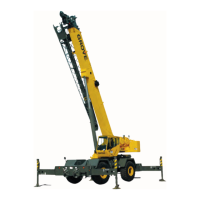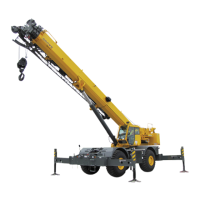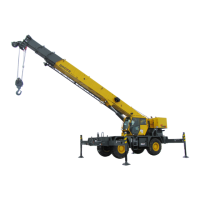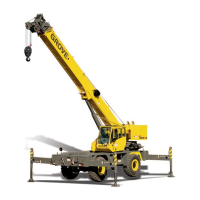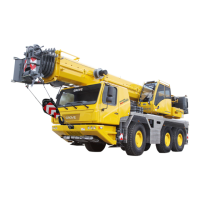4-3
RT9130E-2 OPERATOR MANUAL SET-UP AND INSTALLATION
Published 3-1-2018, Control # 559-03
In order to quick reeve the hookblock without removing the
wedge socket on the end of the cable refer to Figure 4-3.
Boom Cable Reeving
When reeving the boom, always reeve the main hoist wire
rope through the rope grab; if also reeving the auxiliary hoist
rope, reeve the auxiliary hoist rope outside of the rope grab.
DEAD-END RIGGING/WEDGE SOCKETS
Wedge socket assemblies are popular rigging accessories
and have been successfully used for decades to terminate
wire ropes on mobile cranes. A wedge socket assembly is
easily installed and dismantled but it must be installed and
used correctly. It is essential to use only a wedge and socket
of the correct size for the rope fitted. Failure to do so may
result in the rope pulling through the fitting.
Since state and local laws may vary, alternate attachment
methods may be necessary depending upon work
conditions. If alternate methods are selected, the user is
responsible and should proceed in compliance with the
regulations in force. If there are any questions, contact your
local Grove Distributor or Manitowoc Crane Care.
Do not mix components from different manufacturers. The
selection, installation and use of a wedge socket assembly
must be in accordance with the requirements of the wedge
socket manufacturer and the wire rope manufacturer upon
whose wire rope the wedge socket assembly will be used.
Grove specifies the size, type, class and line pulls for wire
rope, predominately rotation resistant wire rope, and rigging
accessories such as overhaul balls and hookblocks for use
with each new crane that it manufactures. Other wire ropes
and rigging accessories are available from various vendors.
Different wire rope manufacturers have differing
requirements for the construction, handling, cutting, seizing,
installation, termination, inspection and replacement of the
wire ropes they produce. Their advice should be sought for
each specific type of wire rope a crane user intends to install
on a mobile crane.
When assembly is complete, raise the boom to a working
position with a load suspended to firmly seat the wedge and
rope into the socket before the crane is used operationally.
When anchoring the socket to the boom, ensure the flat face
of the socket is in position, as shown, away from the boom
sections (Figure 4-4).
.
Installing Wedge and Socket
1. Inspect the wedge and socket. Remove any rough
edges and burrs.
2. The end of the wire rope should be seized using soft, or
annealed wire or strand. If the end of the rope is welded,
the welded end should be cut off. Do not weld on size
6X37 rope. This will allow the distortion of the rope
strands, caused by the bend around the wedge, to
adjust themselves at the end of the line. Refer to Section
1 - Introduction in the Service Manual for wire rope
procedures.
3. Make sure the live-end (Figure 4-5) of the rope is directly
in line with the ears of the socket and the direction of pull
to which the rope will be subjected. If the rope is loaded
into the socket incorrectly, under a load the rope will
bend as it leaves the socket, and the edge of the socket
will wear into the rope causing damage to the rope and
eventual failure.
CAUTION
If the socket is not positioned with the flat face away from
the boom sections, structural damage will occur.

